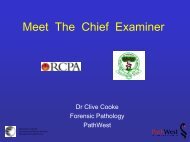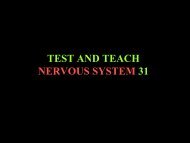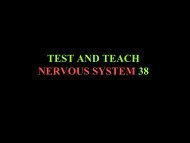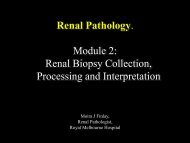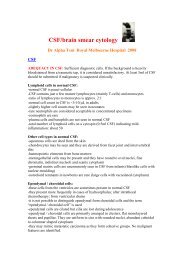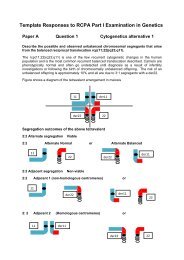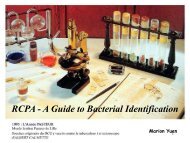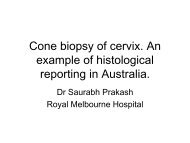Thyroid cytology - RCPA
Thyroid cytology - RCPA
Thyroid cytology - RCPA
Create successful ePaper yourself
Turn your PDF publications into a flip-book with our unique Google optimized e-Paper software.
-numerous neutrophils, degenerate debris<br />
-occasional reactive follicular cells with prominent nucleoli<br />
-may see organisms in the background<br />
Graves’ disease:<br />
-cellular smear with similar features to hyperplastic nodule<br />
-small and large groups of follicular cells with thin colloid<br />
-characteristic flame cells are seen (cytoplasmic vacuoles with red to pink granular<br />
material, corresponding to phagolysosomes)<br />
-considerable nuclear atypia may occur: nuclear enlargement, overlapping, enlarged<br />
nucleoli<br />
-pseudopapillary groups can be seen<br />
-psammoma bodies have been reported<br />
-diagnosis needs to be correlated with clinical history and biochemistry<br />
Granulomatous (subacute, de Quervain’s) thyroiditis:<br />
-in early stage: neutrophils, reactive follicular cells, scarce granulomas<br />
-later stage: granulomas, giant cells, chronic inflammation, few neutrophils, fibrous<br />
fragments<br />
-giant cells often contain phagocytosed colloid<br />
-usually scant follicular epithelium<br />
-“dirty” background with inflammatory cells, colloid (not abundant) and debris<br />
The FNA procedure is often very painful which is a clue to the diagnosis.<br />
Riedel’s thyroiditis:<br />
-almost always paucicellular<br />
-mainly shows fibrous tissue fragments and chronic inflammatory cells<br />
-only few follicular cells present<br />
-granulomas are absent<br />
Hashimoto’s thyroiditis:<br />
-heterogeneous lymphoid population with Hurthle cells. Both must exist to make this<br />
diagnosis<br />
-abundant follicular centre fragments, tingible body macrophages and<br />
lymphoglandular bodies<br />
-lymphocytes embedded within the groups of follicular / Hurthle cells a characteristic<br />
feature<br />
-Hurthle cells may show increased N/C ratio, prominent nucleoli and nuclear<br />
irregularity; some spindling also present<br />
-colloid is scant<br />
-squamous metaplastic cells, foam cells, giant cells, fibrous tissue, granulomas and<br />
psammoma bodies may be present<br />
-beware co-existing Hurthle cell neoplasm (separate monotonous population of<br />
Hurthle cells devoid of lymphocytes), papillary carcinoma or lymphoma<br />
A complete absence of follicular or Hurthle cells should raise possibility<br />
of an intrathyroidal lymph node.




